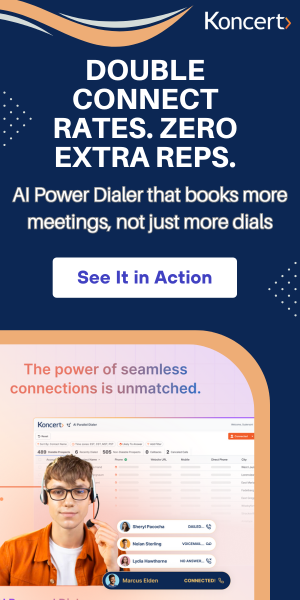6 min read
Account Based Marketing 101: What You Need to Know
By: Koncert Marketing on Sep 12, 2022 6:00:00 AM

What is Account Based Marketing (ABM)?
The demand for a marketing program that develops into a lasting, fruitful partnership is higher than ever. In fact, digital marketing dominates the marketing space, and analytics drive a massive 37% portion of a business’ budget, as the Harvard Business Review reported.
But there is an emerging strategy that holds the potential to solve the sales funnel issues — account-based marketing (ABM). ABM filters target accounts that are excellent sales fits for a company and tailors content marketing, communications, and personalized experiences to that organization.
ABM heavily involves research and dedication. So, what’s the point of this marketing tactic? To nurture high-value clients, boost customer loyalty, and experience a more significant ROI.
This article will discuss everything you need to know about account-based marketing, when to implement an ABM program, and how to introduce the concept to your sales and marketing teams successfully.
Of course, you’re going to need a tool that allows you to manage your ABM clients. With Koncert, you can access software to engage with key decision makers, craft the ideal customer profile, and track essential metrics, all from a customized dashboard.
Who Uses Account-Based Marketing?
Account-based marketing is a B2B marketing approach involving enterprise-level sales reps looking to build long-term client relationships. Because ABM strategies are time-consuming and require dedicated cooperation between marketers and sales reps, they may not be ideal for every organization. You should evaluate if ABM makes sense for your business model and marketing/sales cycles.
The Benefits of Account-Based Marketing
Once you’ve determined that ABM efforts are worthwhile in your organization, it will be critical to share with your sales team the benefits. Implementing a targeted approach to your key accounts comes with the following measurable benefits:
- Personalized relationship with clients. With a customized relationship, your clients recognize the quality you bring in resolving their pain points. This level of personalization reduces customer churn and builds lasting brand loyalty. Customize these relationships to fit the needs of your client and stakeholders to foster that loyalty.
- Streamlined sales cycle. Making your sales cycle more efficient means closing more deals, and ABM programs can help reduce redundancies in the sales cycle. But more importantly, the partnership between your ABM efforts and the client leads to more effortless engagement, making buying easier for them.
- Time and money savings. Initial ABM strategies are time-consuming, but once in place, you’ll be able to recognize accounts that are not ideal. Prioritizing your high-value clients will maximize your business’ relevance and allow you to avoid spending money and time on clients that won’t provide a solid ROI.
- Internal alignment. In order to achieve ABM success, internal departments must have alignment. ABM programs require clear communication between marketing and sales teams to source high-value accounts. This alignment will allow your team members to deliver an exceptional customer experience.
These benefits produce measurable results like improved conversion rates, increased web traffic, and better advertising and conversion rates. Of course, all that translates into more significant revenue potential and bottom-line numbers. Utilize Koncert’s suite of technology to further reap the rewards of ABM!
ABM strategies strengthen personalized client relationships by aligning marketing and sales teams to target high-value accounts, using Milengo's localization and translation services to optimize efforts globally, enhance engagement, and drive retention across diverse markets.
How to Create an Effective ABM Strategy
Now that you’ve seen what account-based marketing can do for your team, it’s time to implement the initiatives into your marketing strategy. But how do you set up an effective ABM campaign that targets the right accounts and translates them into the ideal customer profile? Creating a practical account-based marketing approach is easy and critical to your sales process.
Determine Target Audience
Identifying a high-value account takes some effort and research. You’ll want to start by building a customer persona that includes information like:
- Mission statements, vision, or business objectives
- Product or service needs
- Business maturity
- Revenue model
- Tools and platforms they already use
- Existing pain points
Building this account list provides a point of agreement between your sales and marketing teams. Be sure to look through your current sales funnels for high-value clients you already sell to.
Establish Retention Goals
Closing deals is only part of the equation. But to build a lasting relationship with your high-value accounts, you’ll need to establish your goals for retaining clients. Any marketing efforts are meaningless if you don’t measure retention metrics and share the results. Establish churn metrics to prevent existing customers from slipping away.
Align Internally
Marketing alignment happens when internal teams are all on the same page. Ensure your sales and marketing teams align by agreeing on the target audience and goals. Assign roles and responsibilities based on the marketing approach, resource allocation, and how the new customer will go through the sales process. This step is key to catching miscommunications, potentially adding additional value, and delivering a great experience.
Regularly Monitor Progress
Lead generation, conversion rates, and outreach metrics all require a benchmark to gauge against. Regularly monitoring your real-time progress on these vital KPIs will help you optimize your ABM strategy. Plus, monitoring your metrics helps determine what’s working, potential poor fits in your existing customer base, or missing fundamentals.
Using a tool like Koncert AI to monitor progress will help you learn more about your target accounts. That depth in understanding your performance data will help you capture more sales with minimal effort, especially with the CRM integration.
Seamlessly Manage Accounts
Lead generation happens through multiple marketing channels. Some come from outreach methods like direct mail, while others come from social media like LinkedIn. Regardless of how you obtain your key prospects, you’ll need a relevant way of managing everything. Koncert’s wide selection of tools integrates with your CRM to seamlessly manage your process from sales funnel to customer experience.
Organizations are more likely to invest in businesses with a track record of high-yielding results. Manage your existing accounts, nurture those relationships, and the results will speak for themselves.
Maximize Your ABM Strategy with Koncert
Account-based sales development starts with understanding what ABM is and how to implement it into your organization. Using ABM is time-consuming and involves intense research to uncover the right accounts to engage.
B2B enterprises who are hesitant to implement ABM are missing out on tons of wonderful benefits like internal alignment and strong brand loyalty through personalized experiences.
But it would all be for nothing without proper execution. Finding ABM success comes from defining your target audience, establishing goals, and leveraging your internal alignment between marketing and sales teams. You’ll need to monitor your progress and manage accounts between departments seamlessly.
With so much potential in account-based sales, you’ll need a tool that can handle everything in one easy-to-use platform. Otherwise, you won’t see the full returns.
Koncert Cadence is the management tool you need to help stay on top of the clients you’ve identified as key accounts. Communications with these clients are easy to see, and you can highlight these interactions for follow-up. Plus, enjoy calls, emails, videos, and webinars at your fingertips during every step of the buying process. Try a demo today and start taking advantage of these outstanding relationship-building features!
Related Posts
10 min read
High-Quality Outreach - Why Koncert's ZigZag Dialing® Replaces Call Blasting
Dec 12, 2025 by Koncert Marketing
13 min read
7 Outbound Sales Trends for 2026 - AI, Latency, & Max Connect
Dec 4, 2025 by Koncert Marketing



